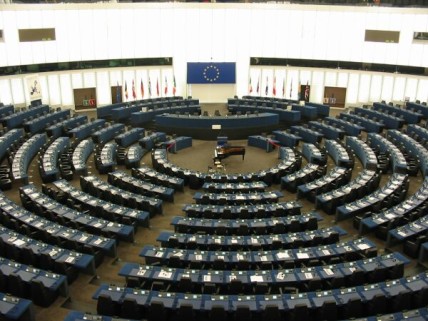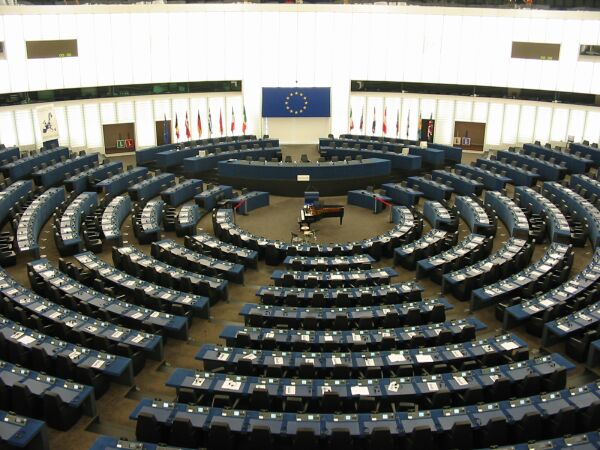
European Parliament, Strasbourg. Photograph by Cédric Puisney
Last month there were revelations about the EU Parliament IT system, and the arbitrary way in which email blocks on legitimate topics can be implemented with lighting speed. This month, Christian Engstrom MEP, has received a response to his complaint from EU President Martin Schulz. It states, in short, that Mr Schulz can’t do maths, and doesn’t understand technology, or the importance of being able to contact elected representatives.
The letter, dated March 28th but delivered April 8th, indicates that the President was aware, and approves of the means used. In short “we got a few hundred thousand emails on this topic, felt it might take down the system and so blocked it all. Plus it was all from less than a thousand email addresses.”
It’s not actually the case though, there’s a lot wrong with the contents of the letter. Firstly, he doesn’t get technology, but also have a big problem with maths, and participatory democracy.
But let’s break down the letter, eh?
Dear Mr Engstrom
Thank you for your e-mail and fax of 12 March in relation to blocking e-mails from citizens concerning the report on “Eliminating gender stereotypes”.
The IT department of the European Parliament noticed on 7 March an excessive number of emails towards EP e-mail boxes coming from external senders.
So here’s the first thing. The IT department gets to decide what an ‘excessive amount’ is. That amount is irrespective of major issues, but seems to be ‘big spike, kill it’. Giving some IT wonk control over whether an issue is ‘important enough’ to be able to contact your elected representatives is not a good thing.
An analysis by the IT department in relation to these external e-mails has shown the following
– The e-mails sent were in relation to the report on “Eliminating gender stereotypes”;
No, really? A filter that blocked emails sent to elected representatives on an issue was in response to emails on that issue. Never would have thought that!
– 708,683 messages were sent to the European Parliament (of which 457,325 were blocked after installing a filter and 251,358 delivered;
So, 708k emails (let’s say 709k and leave it at that round number) were sent, which is a ‘big deal’. There are 754 MEP’s. So, how does that break down? 940 emails per member. It’s not that big a flood (and it’s even smaller than that, as we’ll get to shortly). It’s a month’s worth of email for my primary account, but I also don’t hold an elected position, or have a staff to deal with it.
Also, note the cavalier attitude to blocking 64% of email sent to MEPs by constituents. As if it doesn’t really matter.
– the e-mails were received from 850 different addresses; on average this is more than 800 e-mails per address;
Well, as we’ve already noted, there’s 754 MEPs, so any email sent to all, would go to over 750. Unfortunately, the ‘average’ part is kind of ruined by the very next point.
– One single e-mail address was responsible for sending 106,771 e-mails to the European Parliament;
So, what’s 106,771 divided by the 754 MEPs? 141. 141 people used Rick’s emailer. It’s a good job it wasn’t a huge number of people then, eh?
Now, let’s take that one address out, how does the ‘over 800 average’ last then? Well, 601,912 divided by the 849 address left gives an average of… 709. Not even one to every MEP, and a good chunk from the average he made sound so important.
By the way, anyone have any guesses what that one email address was? Could the answer be found on, say, the much publicised page where the issue was brought up? Why yes it could.
In other words, it is therefore time to mail the European Parliament with our opinions.
You may remember how we did that in the anti-ACTA campaign. I have set up a mail alias that resolves to every Member of European Parliament (all some 750 of them); the mail alias is europarl-all-mar2013@falkvinge.net. Mail them right now, regardless of whether you are an EU citizen or not.
Or it could be the successor address after the blocking issue came up.
Further, you may want to use an alternative mail alias, europarl@piratenpartij.nl.
I think I’ve found the emails…
But, back to President Schulz, and his letter.
– The number of messages per minute shows that there are several levels of continuous sending of e-mails (500 e-mails per minute, 450 e-mails per minute, 400 e-mails per minute etc) which indicates an organised action using automatic means for sending mass e-mails to the European Parliament.
Yes. You are right. There was an organised action. That’s often how citizen pressure works, especially in tight timeframes. We tend to call it ‘activism’ or perhaps ‘campaigning’. You might have heard of it.
Also, all e-mail is sent using ‘automatic means’, you’re hardly logging directly in to the EP server, and typing it out directly on the server. ‘Automated means’ is also a pretty good way to describe multi-recipient emails. You don’t have to send emails out one-by-one, copying the body and putting a new recipient each time.
That’s also why you get blocks of 500, or 400 – mass mail tends to work in batches, it’s not exactly high priority traffic. If it takes 30 extra seconds to get to its destination, no-one cares. It’s not like a video stream, or a website.
I think someone in your IT department has set you up to look like an idiot, Mr Schulz (that’s BOFH’s for you)
– when analysing the servers from which the e-mails were sent, two main servers have been identified which are responsible for sending the vast majority of the e-mails to the European Parliament;
Yeah, we already mentioned them. Did you? No, because if you revealed that it was a Dutch political party, and a well-known political activist who is the founder of an entire political movement with elected members of the EP, then the perceived rational goes from ‘spam blocking’ to ‘political muzzling’.
Considering that the European Parliament receives on average 250,000 e-mails from external senders per day and that in addition 230,000 e-mails concerning the report on “Eliminating gender stereotypes” were received, this is a strong indication that the European Parliament is being targeted by mass e-mail.
First of all, the European Parliament collectively receive less than 250,000/day? That’s not a good sign. When you add in lobbying, automated lists and that there are thousands of email addresses in the EP (not just one per MEP, but all their staff etc) that’s a REALLY low number. Say 3 staff, plus the MEP, that’s 3000 email addresses, and 250k doesn’t sound a lot now. In fact the European parliament itself says there’s over 6600 people working at the European Parliament, so it works out to 37/day. I’ve had 42 emails between midnight at 2pm, and it’s been a quiet day.
Second, yes, we know it was targeted by mass email. That’s what a mass email protest looks like, when something a lot of people feel strongly about is revealed. 30 years ago, they would have written, and because of the way the postal services works, it would have been spread out over days as word took time to spread, and then people write, and the postal services delivers. Now the word can spread globally in minutes, and responses hit your inbox quicker than a pizza can be delivered. It’s the modern world, and if you can’t understand that, then you have no business being President.
In order to guarantee the functionality of the European Parliament’s e-mail system (which is one of the essential services offered to the European Parliament) it was decided to install a filter at 9:30 to reduce the number of external emails in relation to the report on “Eliminating gender stereotypes”
OOPS! Someone’s been caught out in a lie. See, we have this tweet from the European Parliament which says something a bit different.
Automatic filters were triggered on 7 March because of an enormous influx of mails sent to MEPs – nothing to do with content #mepblock
— European Parliament (@Europarl_EN) March 8, 2013
Except as we now know, it wasn’t automatic. It was deliberately put in place because of people contacting MEPs, according to Mr Schulz
Seriously, don’t say it’s an automatic filter when it’s actually a response to a campaign against a topic. That’s NOT GOOD. Secondly, the European Parliament is filtering based on responses to a certain topic, RELEVENT to pending legislation. That’s COMPLETELY different from “nothing to do with content”
And sure an email storm is going to affect email servers, if they’re badly set up. The reasoning is that there’s a certain level of e-mails and beyond that is too much’. Again, doesn’t really work that way. Any properly set up email system should have no problem with this volume of mail, which can’t be said for the MEPs. This is ably demonstrated by British MEP Charles Tannock who replied to the Eu Parliament tweet saying
.@Europarl_EN Appreciated as MEPs overwelmed with lobbying email on farming & internet freedom-price of free & instant acces to elected reps
— Charles Tannock (@CharlesTannock) March 8, 2013
That’s not a great thing for the ECR Foreign Affairs and Human Rights Coordinator to say. Perhaps if those emailing had taken him to dinner, like a PROPER lobbyist, he’d have been more receptive. Plus it flies in the face of the Article 8 of the European Declaration of Human Rights
1. Everyone has the right to respect for his private and family life, his home and his correspondence.
2. There shall be no interference by a public authority with the exercise of this right except such as is in accordance with the law and is necessary in a democratic society in the interests of national security, public safety or the economic well-being of the country, for the prevention of disorder or crime, for the protection of health or morals, or for the protection of the rights and freedoms of others.
Clearly there is no respect for correspondence from the President or the IT department, and there has been interference by a public authority with the exercise of this right. Indeed, blocking out communications with elected representatives on a single topic is a clear and flagrant violation of Article 8.
After the filter was installed, the European Parliament received 250,000 additional e0mails by 16:00 of the same day. At noon on 8 March there were 500,000 e-mails and on 9 March 708,683 e-mails in total were received from external sources all in relation to the report on “Eliminating Gender stereotypes.
Again, undermining your position a bit here, Martin. Rick’s original piece was published 21:30 on March 6. After 12 hours, you had 250,000 emails in on the topic, which were let through before you installed a block. So until the block (roughly 10am March 7) was installed, you had 251,358 emails.
Next you say that after the filter, you had another 250,000 emails by 16:00 that day (the 7th), for a total of 501,000 emails.
Your next line says that by noon on the 8th, you had 500,000 emails. I’m assuming that’s blocked, because you were already over that, total, 20 hours earlier. So that’s 751,000 emails. Then you close by saying by the 9th, you’d had a total of 708,683 emails.
The problem is, you’ve already accounted for more than that at noon on the 8th.
The numbers DO NOT ADD UP as presented. The only way they would, is if those that were delivered circumvented the filter, and there were very few emails sent before the filter was implemented.
That and now you’ve explained the number wasn’t 709k emails in 24 hours, but really spread out between March 6 and March 9 (3 days) it seems even less of a threat, with less than the quantity of email you admit to finding ‘average’. Hardly a tsunami of email.
Out of the 708,683 e-mails, 457,325 were blocked (after installing a filter) and 251,358 were delivered. No e-mails have been deleted or cancelled, and all e-mails which have been blocked are in the “quarantine” part of the infrastructure.
Hmm, that’s nice. Not deleted or cancelled, but just held in indefinite storage, in a folder no-one can access. If you move emails to the ‘trash’ folder, or files to the Recycle bin’, you’ve not deleted them either, but just ‘put them in quarantine’.
Sure you’ve not actually deleted them, they still exist, but as far as the recipients are concerned, they have been de-facto deleted. I asked Christian Engstrom MEP about these emails, and if he’d been sent any that had passed ‘quarantine’ His reply?
No, they have not been delivered to MEPs .The IT department may have them somewhere, but since MEPs cannot access them directly, and are probably not even aware of their existence in most cases, that is no help. For all practical purposes, the emails were discarded without any notice given either the citizen sender or the MEP recipient
Yet another lie, effectively, from President Schulz.
In conclusion, considering the high number of e-mails received in a very short period of time the limited number of different email accounts (850) used to send the e-mails, the usage of automated means for producing the e-mails and the usage of mainly two servers to send the e-mails , the IT department considered that the European Parliement was the subject of an abnormal massive e-mail flow and that the intervention of the technical services is justified to install a filter to reduce the number of messages from external sources concerning the report on “Eliminating gender stereotypes” in ordre to ensure the functioning of the European Parliament e-mail service.
There are two possible translations for this paragraph.
Translation 1:
The IT department is poorly trained and has implemented an email service that is barely capable of handling the normal everyday load, since there are too many people skimming from the budget and going to pet-vendors. As such, any influx casued by an issue of concern to may will overwhelm the creaky mess unless CYA mode is engaged and filters implemented.
Translation 2:
I am a strong supporter of the issue many people were protesting about. I support the block, because I want the legislation to pass, and with the help of people in the IT department have devised an excuse that we feel will justify blocking correspondence between the citizens of the EU and the Members of the European Parliament. If only we’d have thought of this in time to save ACTA.
Neither one is very appealing, or bodes well for democracy, or the view many have for the EU’s legislative body.
Either way though, the message this letter gives is that you shouldn’t contact MEP’s if there’s a serious issue, but if you absolutely must, don’t use email. EU citizens contacting MEP’s about issues that are important for them is not what the e-mail system is for. Use two cups and a bit of string instead, it’ll work just as well.
What are your thoughts? Translation 1, 2 or is there a 3rd?




